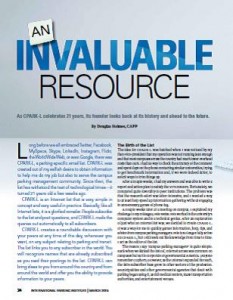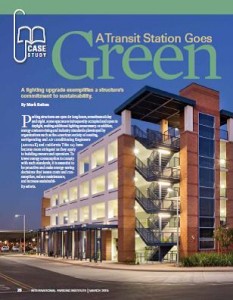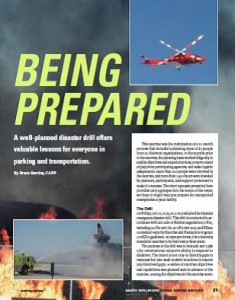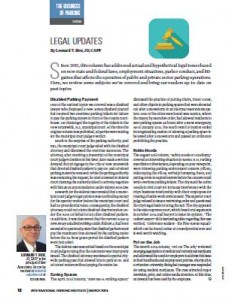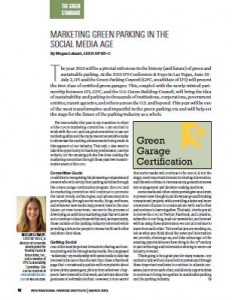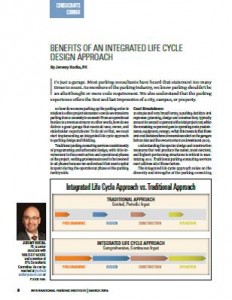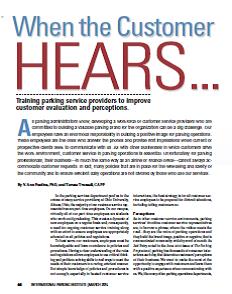 By V. Ann Paulins, PhD, and Teresa Trussell, CAPP
By V. Ann Paulins, PhD, and Teresa Trussell, CAPP
As parking administrators know, developing a workforce of customer service providers who are committed to building a valuable parking brand for the organization can be a big challenge. Our employees have an enormous responsibility in building a positive image for parking operations. These employees are the ones who answer the phones and provide first impressions when current or prospective clients seek to communicate with us. As with other businesses in which customers drive the work environment, customer service in parking operations is essential. Unfortunately for parking professionals, their business—in much the same way as an airline or finance office—cannot always accommodate customer requests. In fact, many policies that are in place for the well-being and safety of the community and to ensure efficient daily operations are not favored by those who use our services.
In the parking services department (and as in the offices of many service providers) at Ohio University, Athens, Ohio, the majority of our customer service representatives are part-time employees. On our campus, virtually all of our part-time employees are students who work until graduating. This creates a dynamic of new employees on a regular basis and, consequently, a need for ongoing customer service training along with an effort to ensure employees are appropriately educated on all policies and regulations.
To best serve our customers, employees must be knowledgeable and have confidence in policies and procedures. Having a clear understanding of the rules and regulations allows employees to use critical thinking and problem-solving skills to find ways to meet the needs of their customers in a caring, efficient manner. But simple knowledge of policies and procedures is not enough; especially in heated customer service interactions, the best strategy is for all customer service employees to be prepared for difficult situations, including telling customers no.
Perceptions
As in other customer service environments, parking services’ frontline customer service representatives are, to borrow a phrase, where the rubber meets the road—they are the voice of parking operations and they build the brand image, positive or negative, that is communicated community-wide by word of mouth. As Jeff Petry noted in the June 2014 issue of The Parking Professional, parking has thousands of consumer interactions each day that determine customers’ perceptions of their business. We want to make the most of the opportunity to engage with customers and leave them with a positive experience when communicating with us. We, like many other parking operations departments, are often unpopular and battle negative stereotypes associated with parking enforcement activities.
At Ohio University, the parking office partnered with the academic retailing program in the Patton College of Education to study customer service in the parking program and, in particular, explore what happens when customers hear “no.” We investigated how clients rated the services they received during patron-initiated telephone encounters and compared the customer service ratings between those whose requests were able to be honored and those whose requests were denied.
We employed independent researchers who listened to and rated the service provided by parking employees using a previously established service quality scale. Simultaneously, we employed the Ohio University Scripps College Research and Survey Center to survey the customers themselves, using the same scale. What we found did not surprise us: Independent evaluators rated the customer service quality the same regardless of whether requests were met or not, but the customers whose asks were denied rated our services levels less favorably than customers whose requests were met. This gives us a strong rationale to attend to the perception of customer service provided by our parking employees and develop a best-practices approach to mitigate the inevitable outcome of perceived poor services when we are unable to accommodate individual requests.
How Customers Hear “No”
Parking operations staff are all too familiar with the typical situations often leading to customer requests being unmet. During the period of our study, the following situations comprised the reasons customer requests were denied:
- Wanted a better reserved parking space when none were available.
- Ineligible for campus parking but wanted parking privileges.
- Wanted citation to be voided.
- Wanted access to parking lots that were closed for other events.
- Wanted a boot removed free of charge or a tow reimbursed.
- Wanted policies and procedures changed to accommodate their specific needs or wants.
Driving Best Practices
Based on previous experience, word-of-mouth, or the unpleasant event of being ticketed and fined for their failure to follow parking rules, customers often form negative impressions well before they call our office. These preconceived perceptions carry over and they form an opinion before they ever speak to a customer service representative. Therefore, even when customer service employees are performing at exceptional levels, customers can be emotionally unable to recognize the caring and responsive service.
Best practices revolve around the concept of empathy, which requires time and attention of customer service providers. Delivering empathy effectively to customers requires authenticity. This is a quality that may or may not come naturally to the service provider, but it can be taught through ongoing customer service training. We found specific case studies provide great resources for the process of delivering high quality customer service with four steps.
Many customer requests that result in hearing “no” originate because of a need to solve an individual dilemma. More often than not, our customers don’t really know what they want or need but, rather, focus on one request they believe will solve their situation; it may not be the best solution at all. The following case study, a real example that emerged in the collaborative research we conducted, illustrates this concept and serves as a training module for customer service.
Case Study: Molly
The scenario: Molly called the parking office saying that she needed a commuter permit. However, Molly did not qualify for that permit due to her proximity to campus.
Step 1: Listen to the customer’s stated need and ask the right questions.
Customers do not often give their full stories. Typically, they state a request instead of their actual need. Parking employees need to listen to the statements made by customers and then exhibit empathy by asking questions that are appropriate to the customer’s particular situation. The customer service representative here could have easily stated Molly’s ineligibility without further questions and discontinued the encounter. By doing so, the customer service provided would have been neither rude nor inaccurate and would have answered the customer’s question. However, offering positive and empathetic service requires greater depth of understanding of the customer’s unasked question.
The parking services employee asked Molly more about her particular situation and why she wanted a commuter permit. He learned more about Molly’s predicament— she lived off campus but needed a parking spot relatively close to school so she could attend class and quickly access her car to get to her job several miles off campus. Further investigation by the employee revealed that the commuter permit Molly wanted was not actually the best solution to her dilemma. Parking operations maintains an updated list of alternative off-campus parking vendors that employees are encouraged to share with customers such as Molly.
In this case, the customer’s need was met even though she initially heard “no,” and her evaluation of service was strong. More outcomes like this are possible, and we have enhanced our employee training in an effort to have employees seek and respond to the unasked questions.
Step 2: Be attentive to tone of voice, especially on the telephone.
Parking services providers should be upbeat. Voice tone sends an unspoken message to customers. They may feel they are annoying you with one tone, while another lets them enjoy speaking with you. Even when saying all of the right things, the voice tone can be either off-putting or reassuring. Especially when they’re upset, customers may only hear the employee’s tone, not the words.
Step 3: Convey positive mannerisms and body language.
While our research project focused on customer service in phone conversations, we included non-verbal communication strategies in our training modules. Positive mannerisms include making eye contact and exhibiting professional posture that says, “I am listening to you and I am interested in what you are saying.” Our young (and typically inexperienced) employees need to be trained to actively refrain from sighs, eye rolls, arm crossing, lounging posture, and other negative body language.
Step 4: Summarize and offer a positive and empathetic close.
When concluding a customer service encounter, especially when the customer has heard “no,” employees should summarize the content of the discussion, re-state the customer’s real problem, and review suggested alternative solutions to the initial request. A positive, caring closing statement should be the final memory that the customer takes away from the interaction. As Maya Angelou said, “People will forget what you said, people will forget what you did, but people will never forget how you made them feel.”
Training is essential and makes a differencein creating a positive work environment, as well as providing a positive customer relations environment. Ensuring customer service employees are armed with basic customer service skills, such as listening to the customer and hearing him out, repeating what the customer said and probing with more questions, providing options for the customer that fit within policy, all while maintaining a pleasant tone, allows your employees to effectively do their jobs and keep situations from escalating. Dealing with an angry customer is tricky, and training is key to ensuring that all customers feel satisfied even if they hear “no.”
V. Ann Paulins, PhD, is senior associate dean, research and graduate studies, at the Gladys W. and David H. Patton College of Education at Ohio University. She can be reached at paulins@ohio.edu.
Teresa Trussell, CAPP, is parking operations supervisor at Ohio University. She can be reached at trussell@ohio.edu.


